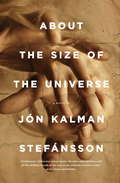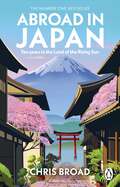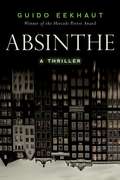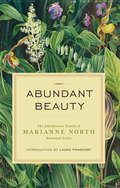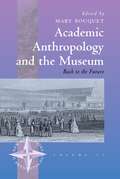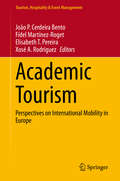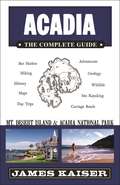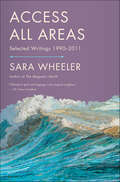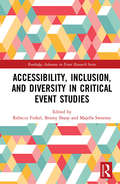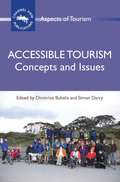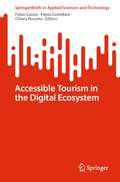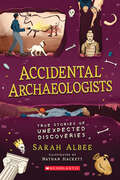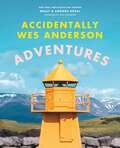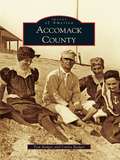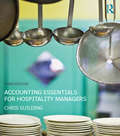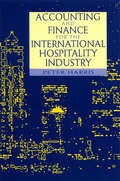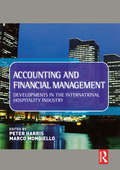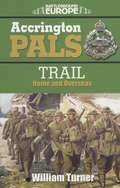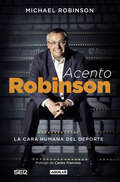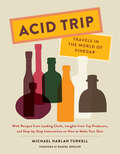- Table View
- List View
About the Size of the Universe
by Jón Kalman StefánssonA modern saga spanning the whole of the 20th century, by one of Iceland's most celebrated writers.At the beginning of this story there is death, and yet it is a celebration of life - the passion between a man and a woman, forbidden love, violence, sorrow, betrayal. Happiness and misfortune are passed down from one generation to the next. The sorrow over what was and what might have been weighs heavily on the characters and at the end of this chain, for now, stands Ari, on his way to his dying father, with a score still to be settled. The raw beauty of life is written into the dramatic Icelandic landscape, and into a society that has undergone great transformation within a century. In language both archaic and lyrical, and yet entirely contemporary and full of humour, Jón Kalman Stefánsson proves himself one of the finest European writers of his generation.A companion volume to Fish Have No Feet (longlisted for the Man Booker International Prize 2017).Translated from the Icelandic by Philip Roughton
Above Victoria and Vancouver Island
by Russ Heinl Gillian BirchABOVE VICTORIA AND VANCOUVER ISLAND is a stunning collection of 105 aerial photographs of Vancouver Island, BC taken by renowned photographer, Russ Heinl. This high-quality ebook offers a series of breathtaking images, capturing aerial views of Vancouver Island's spectacular landscapes in precise detail. Heinl's diverse subjects range from the ivy-covered Empress Hotel in Victoria to surfers riding world-class surf at Tofino and Long Beach. Those who enjoy British Columbia's great outdoors will appreciate these awe-inspiring aerial views of Vancouver Island's magnificent snow-capped peaks of Mount Washington and Strathcona Provincial Park. Nature lovers will pore over the images of Grey Whales, right down to the barnacles on their tail fins as the whales complete their annual migration along the coast of Vancouver Island, celebrated by thousands attending the Pacific Rim Whale Festival. See "The Snowbirds" flying in formation over Vancouver Island, seals basking on rocky offshore islets and a host of magnificent coastal views captured in this stunning ebook of aerial photographs. Chapters feature Tofino, Long Beach and the Pacific Rim National Park, Port Hardy and Cape Scott, the scenic waterfront at Nanaimo, Victoria, the elegant capital city of British Columbia and its suburbs of Sidney and Sooke. Using the latest gyro-stabilized Nikon camera systems these stunning views of the earth from the air show Vancouver Island at its very best. From the open door of the helicopter, aerial photographer Russ Heinl has captured the charismatic splendour and remote natural beauty of Vancouver Island, its cities, mountains, beaches and wildlife. Enjoy these aerial views time and time again with this beautiful photography ebook of Victoria and Vancouver Island.
Abroad in Japan: The No. 1 Sunday Times Bestseller
by Chris BroadTHE NUMBER ONE BESTSELLER'Chris Broad explores Japan in all its quirky glory..Endlessly fascinating!'Will Ferguson, author of Hokkaido Highway Blues'Carves a unique path across Japan bringing him into contact with far too many cats, heartening renewal in Tohoku, and even pizza with Ken Watanabe.'Iain Maloney, author of The Only Gaijin in the Village'Fascinating, fact-packed and very funny..An excellent and enjoyable read for the Japan-curious. I loved it and learned a lot.'Sam Baldwin, author of For Fukui's Sake: Two years in rural JapanWhen Englishman Chris Broad landed in a rural village in northern Japan he wondered if he'd made a huge mistake. With no knowledge of the language and zero teaching experience, was he about to be the most quickly fired English teacher in Japan's history?Abroad in Japan charts a decade of living in a foreign land and the chaos and culture clash that came with it. Packed with hilarious and fascinating stories, this book seeks out to unravel one the world's most complex cultures.Spanning ten years and all forty-seven prefectures, Chris takes us from the lush rice fields of the countryside to the frenetic neon-lit streets of Tokyo. With blockbuster moments such as a terrifying North Korean missile incident, a mortifying experience at a love hotel and a week spent with Japan's biggest movie star, Abroad in Japan is an extraordinary and informative journey through the Land of the Rising Sun.Number one Sunday Times bestseller, August 2023
Absinthe: A Thriller
by Guido EekhautWalter Eekhaut (his name rhymes with "stakeout"), a veteran of the Belgian police force who has a problem with authority, is dispatched to Amsterdam to aid the Dutch security service in investigating the activities of a well-connected Russian oligarch, with connections to Putin. Some of the Russian's business is certainly legitimate, but some may well not be. In Amsterdam, Eekhaut is seconded to Chief Superintendent Alexandra Dewaal and her team, and begins to learn about the city's shady underside. He is at once pulled into another case, the murder of a young leftist dissident, alleged to have stolen a sensitive list from the Amsterdam offices of an ultra-right-wing political party-a list with the name of secret donors. The hunt for the killer leads to a knot of black money interests and illegal dealings that pit the Russian mob and Dutch politicians and business leaders against the police and anyone else who tries to get in their way. Absinthe is the gripping first installment in the bestselling Amsterdam trilogy featuring Eekhaut and Dewaal and, for North American readers, a new voice in European noir.
Abundant Beauty
by Laura Ponsonby Marianne NorthIn 1871, Marianne North, a brilliant artist with a keen interest in botany, set-forth to travel the world on a quest to paint indigenous plants in their natural habitat. Encouraged by her friend Charles Darwin, North travelled by boat, train, mule, foot and palanquin to every continent except Antarctica. She circled the globe twice over fifteen years and accumulated an extensive and valuable collection of more than eight hundred paintings, which today comprise the esteemed Marianne North Gallery at the Royal Botanical Gardens at Kew, London.North - high-spirited, indefatigable, and brave - also kept detailed journals, which were posthumously published in three volumes in the late 1800s. Abundant Beauty collects the most engaging writings from those journals in one edition, including rich descriptions of botanica and delightful accounts of local people and customs from her sometimes dangerous travels. Abundant Beauty is a fascinating and informative read for botanists, gardeners, historians, and armchair travellers.
Academic Anthropology and the Museum
by Mary BouquetThere is ample evidence that anthropologists are among those whose imaginations have been fired by the museum, over the past fifteen to twenty years.
Academic Tourism: Perspectives on International Mobility in Europe (Tourism, Hospitality & Event Management)
by João P. Cerdeira Bento Fídel Martínez-Roget Elisabeth T. Pereira Xosé A. RodríguezThis book presents the latest knowledge on the still under-researched field of academic tourism, which over the past decade has gained in importance at local and national economic levels as a result of increasing international mobility of students and academic staff in higher education. A wide range of themes are explored from various perspectives, with the focus on Europe. Particular attention is paid to academic tourism demand, expenditure, and economic impact; the relationships between academic tourism and local and regional development, sustainable development, and environmental sustainability; and the importance of academic tourism for the internationalization of higher education and international cooperation and development. Further topics to be considered include the significance of academic tourism for the dynamics of tourism destinations and insights from experimental tourism research. In addition to theoretical chapters and state of the art reviews, readers will find insightful empirical and case studies. The book will be of interest to academics, researchers, students, and practitioners, including policy makers.
Acadia Panorama: Images of Maine's National Park
by Alan NyiriThe pictures tell the story in these panoramic photos from all reaches of Acadia National Park and vicinity. Subjects range from delicately detailed close-ups to dramatic, wide-ranging views. Photographer Alan Nyiri captures his photos with a panoramic camera, which offers a full 140DG span. An introduction gives a fascinating glimpse into the mind and methods of a master landscape photographer, and captions identify and provide background about the images.
Acadia's Carriage Roads
by Robert ThayerThe third title in the Acadia National Park guide series, Acadia's Carriage Roads covers the history, geology, and biology of the area. It includes practical advice and maps to help visitors get the most from their tours of the roads, whether on foot, by bicycle, or on cross-country skis. With their work-of-art stone bridges, these crushed-rock carriage roads — the result of decades of effort by philanthropist John D. Rockefeller Jr. — are known throughout the world for their beauty.
Acadia: The Complete Guide: Mt Desert Island And Acadia National Park
by James KaiserThis gorgeous, full-color travel guide reveals the highlights and hidden gems of Acadia National Park and Mount Desert Island, Maine. From outdoor adventures (hiking, biking, sea kayaking, sailing) to the top lobster restaurants in Bar Harbor, Acadia: The Complete Guide puts the best of Acadia at your fingertips. Fascinating chapters on geology, history, ecology and wildlife bring the park to life. Over 20 detailed maps make travel planning easy. Written and photographed by Maine native James Kaiser, Acadia: The Complete Guide offers dozens of insider tips to help you make the most of your time in the park. Whatever your interests--driving the Park Loop Road, hiking to the top of Cadillac Mountain, biking the Rockefeller Carriage Roads, sailing past historic Bass Harbor Lighthouse--Acadia: The Complete Guide is the only travel guide you'll need. The Bestselling Guidebook to Acadia for over a Decade! Over 150 Color Photographs Over 20 Detailed Maps Fascinating Chapters on Geology, Ecology, Wildlife and History Detailed Info on Hiking, Biking, Sea Kayaking and Sailing Filled with Tips to Save You Time and Money!
Access All Areas: Selected Writings 1990–2011
by Sara WheelerAdventures in going forth and staying put from one of our greatest travel writersIn vivid, urgent books such as Terra Incognita and The Magnetic North, Sara Wheeler reckoned with the allure and brutality of life on the fringes, exploring distant lands with an extraordinary sensitivity to history, to place, and to the people who inhabit them. Access All Areas collects the best essays and journalism by a writer who has used extreme travel as a means to explore an inner landscape. Ranging from Albania to the Arctic, Wheeler attends a religion seminar aboard the Queen Elizabeth 2 and defrosts her underwear inside an igloo. She treks to distant Tierra del Fuego—"a place where nothing ever happened"—and to the swamps of Malawi, a place so hot that toads explode. She crosses dubious borders with nothing but a kidney donor card for ID and learns to wing walk and belly dance, though not at the same time. Charming, scathing, restless, and eternally amused, the writer we meet in Access All Areas has spent a lifetime investigating roots and rootlessness. Seeking only to satisfy her own curiosity, Wheeler shows us the world.
Access to Mass Transit for Blind and Visually Impaired Travelers
by William R. Wiener Mark M. Uslan Alec F. Peck Arlene SternAccess to Mass Transit addresses travel issues vital to independence for blind and visually impaired persons from several perspectives- those of blind and visually impaired persons who use mass transit, orientation and mobility instructors, and transportation professionals. Focusing on national and international issues, this information-filled manual covers approaches to making mass transit accessible in several cities in the United States and in Canada, the United Kingdom, and Japan. Arranged in a well-illustrated, easy-to-use format, tips, techniques, guidelines, and adaptive strategies are presented for safe and independent travel on subways, buses, and commuter rails.
Accessibility, Inclusion, and Diversity in Critical Event Studies (Routledge Advances in Event Research Series)
by Rebecca Finkel Briony Sharp Majella SweeneyMost early social research into planned events had the effect of broadcasting narratives of dominant cultures and privileged groups. More recently, however, convergences of gender, sexualities, ethnicities, age, class, religion, and intersectional analyses and events studies have started to drive new critical understanding of the impacts of events on non-mainstream, non-majority communities around the globe. This timely book addresses current gaps in the literature surrounding issues of accessibility, inclusion, and diversity in various event landscapes. Structured into four parts covering the main types of events, the chapters present original topics using innovative methodological approaches. Each chapter employs a case study to illustrate the key intertwining issues in these various experiential realms. Further, the chapters are all cross- or interdisciplinary, drawing on gender, sexualities, cultural, race/ethnicity studies as well as multiple literatures that feed into critical events studies and exploring a variety of global examples. This significant book opens the path to further research on the role and importance of accessibility, inclusion, and diversity in events environments worldwide. It will be of interest to academics and researchers of critical event studies as well as a number of related social science disciplines.
Accessible Tourism
by Dimitrios Buhalis Simon DarcyInclusion, disability, an ageing population and tourism are increasingly important areas of study due to their implications for both tourism demand and supply. This book therefore sets out to explore and document the current theoretical approaches, foundations and issues in the study of accessible tourism. In drawing together the contributions to this volume the editors have applied broader social constructionist approaches to understanding the accessible tourism phenomena. Accessible tourism, as with any area of academic study is an evolving field of academic research and industry practice. As with other areas of tourism, the field is multidisciplinary, and is influenced by various disciplines including geography, disability studies, economics, public policy, psychology and marketing.
Accessible Tourism in the Digital Ecosystem (SpringerBriefs in Applied Sciences and Technology)
by Fabio Cassia Paola Castellani Chiara RossatoThis book explores the growing demand for accessible tourism experiences and demonstrates how the perspective of digital ecosystems can play a vital role in creating more inclusive destinations. Through a combination of conceptual arguments and real-world case studies, the book sheds light on the practical aspects of accessible tourism. Statistics reveal that over one billion people have severe or moderate disabilities, emphasizing the urgent need for enhanced accessibility in tourism. However, both industry practices and academic research in this field are still lagging behind. The book highlights the challenge of establishing coordination among various stakeholders, including transport operators, hospitality firms, and public authorities, which has hindered the design and implementation of inclusive tourism experiences. By harnessing the power of new technologies, the book illustrates how digital ecosystems can effectively facilitate accessible tourism. It examines the demand for such experiences and demonstrates how embracing a digital ecosystem perspective can contribute to the development of more accessible tourism destinations. In addition to its theoretical insights, the book delves into several practical case studies that showcase successful examples of accessible tourism.
Accidental Archaeologists: True Stories of Unexpected Discoveries
by Sarah AlbeeScience meets real-life mystery in this adventurous look at incredible unexpected finds that changed history.Secret treasures are buried all around us -- you just have to look for them!Accidental Archaeologists takes you on an adventure through time to relive some of the coolest surprise discoveries by totally ordinary people all over the world. Meet:- The cowboy who found an ancient skeleton- A famous king buried underneath a parking lot- The team who found New York City's hidden African Burial Ground- A boy who finds the Dead Sea Scrolls while looking for his lost goat- And many more.Packed with incredible stories and expert tips for making your own exciting finds, this is an accessible, action-packed introduction to the world of archaeology.
Accidentally Wes Anderson: Adventures (Accidentally Wes Anderson)
by Wally Koval Amanda KovalAdventure awaits in this new visual odyssey from Accidentally Wes Anderson, taking readers on stunning trips to every continent and sharing oddly moving human tales along the way. For lovers of travel, design, and exploration, AWA presents a brand-new collection of real-world places that seem plucked from the films of Wes Anderson, and the stories that bring each location to life. You&’ll venture to Antarctica through the treacherous Drake Passage, make a stop in lesser-known Jincumbilly, Australia (where platypuses outnumber people), discover the bridge in Wisconsin that went to nowhere, and drop into the most peculiar umbrella shop in London. But adventure means nothing without someone to tell the tale. You&’ll meet the father of American skydiving, who created the officially-sanctioned center of Earth—a California town with a population of two. You&’ll visit the &“post office at the end of the world&”—and meet its mustachioed letter carrier, who runs an anarchist island nation in his free time. And you&’ll travel to a town in the Arctic Circle where cats are prohibited, humans may not be buried, and doomsday vaults hold all we need to survive an apocalypse—including the secret recipe for the Oreo cookie. Authorized by the legendary filmmaker himself, Accidentally Wes Anderson Adventures reminds us that the world is ours to explore.
Accomack County
by Curtis Badger Tom BadgerAquarena Springs was the culmination of a dream shared by two men: Arthur Birch (A. B.) Rogers and his son Paul J. Rogers. The Spring Lake Park Hotel opened at the headwaters of the San Marcos River in 1929. Soon, Aquarena Springs would become one of the premier tourist destinations in the Southwest. Attractions such as glass bottom boats, a Swiss sky ride, Texana Village, and the world's only submarine theater delighted hundreds of thousands of visitors each year. From special events like the underwater wedding featured in Life magazine to the daily antics of nationally known Ralph the Swimming Pig, Aquarena provided entertainment and created lifelong memories for countless families. In recent years, under the auspices of the River Systems Institute at Texas State University, Aquarena has become an important center for environmental education and research.
Accounting Essentials for Hospitality Managers
by Chris GuildingFor non-accountant hospitality managers, accounting and financial management is often perceived as an inaccessible part of the business. Yet having a grasp of accounting basics is a key part of management. Using an 'easy to read' style, this book provides a comprehensive overview of the most relevant accounting information for hospitality managers. It demonstrates how to organise and analyse accounting data to help make informed decisions with confidence. With its highly practical approach, this new Edition: Quickly develops the reader's ability to adeptly use and interpret accounting information to further organisational decision making and control Demonstrates how an appropriate analysis of financial reports can drive your business strategy forward from a well-informed base Develops mastery of key accounting concepts through financial decision making cases that take a hospitality manager's perspective on business issues Presents accounting problems in the context of a range of countries and currencies Includes a new chapter that addresses a range of financial management topics that include share market workings, agency issues, dividend policy as well as operating and financial leverage Includes a further new chapter that provides a financial perspective on revenue management Includes accounting problems at the end of each chapter to be used to test knowledge and apply understanding to real life situations Offers extensive web support for instructors and students that includes powerpoint slides, solutions to end of chapter problems, test bank and additional exercises. The book is written in an accessible and engaging style and structured logically with useful features throughout to aid students’ learning and understanding. It is a key resource for all future hospitality managers.
Accounting and Finance for the International Hospitality Industry
by Peter HarrisTop experts specializing in hospitality management have contributed articles to this new collection which explains recent developments in accounting and finance. The material is drawn from a combination of fieldwork and practical experience. The managerial emphasis means that the content is fully relevant internationally and not constrained by the legal framework of different countries. Accounting and Finance provides an overview of:*analysis and evaluation of performance *planning methods and techniques *financial information and control *financial management. It also shows how operational analysis can be used as a management tool to improve performance. Techniques for predicting the financial success or failure of hotels are suggested. Research into hotel companies in the US and Europe demonstrates key performance indicators used by hotel managers and financial executives. Other contributors explore the interface between accounting and marketing and human resource management and there is thorough coverage of financial strategy formulation. Readers will also find helpful the section on statistics in the analysis and prediction of cost behaviour in hotels.Contributors: Raymond Schmidgall (Michigan State University, USA); Debra J. Adams (Bournemouth University, UK); Professor Elisa S. Moncarz (Florida International University, USA); Richard N. Kron (Kron Hospitality Consulting, USA); Angela Maher (Oxford Brookes University, UK); Peter J. Harris (Oxford Brookes University, UK); Geoff S. Parkinson (BDO Stoy Hayward Chartered Accountants, UK); Paul Fitz-John (Bournemouth University, UK); Paul Collier (University of Exeter, UK); Professor Alan Gregory (University of Glasgow, UK); Tracy A. Jones (Cheltenham and Gloucester College of Higher Education, UK); Jacqueline Brander Brown (The Manchester Metropolitan University, UK); Nina J. Downie (Oxford Brookes University, UK): Catherine L. Burgess (Oxford Brookes University, UK); Ian C. Graham (Holiday Inn Worldwide, Belgium); Howard M. Field (International Hotel and Leisure Associates, UK); Professor Paul Beals (Canisius College, USA); Frank J. Coston (Pannell Kerr Forster Associates, UK).
Accounting and Financial Analysis in the Hospitality Industry
by Jonathan A. HalesUnderstanding and applying accounting principles and financial analysis.
Accounting and Financial Management
by Peter Harris Marco MongielloAccounting and Financial Management: developments in the international hospitality industry presents new and innovative research and developments in the field of accounting and financial management as it relates to the work of managing enterprises and organisations in the international hospitality industry. The content contains contributions from a rich source of international researchers, academics and practitioners including, university and college lecturers, professional accountants and consultants and senior managers involved in a wide range of teaching, scholarship, research, and consultancy in the hospitality industry worldwide. The material is drawn from their work and experience and relates directly to the management of hospitality undertakings. Therefore the up to date case studies and examples used are taken from a wide ranging of companies across the industry including large international chains such as Sheraton, Holiday Inn, and Intercontinental. Divided into three parts: Performance Management, Information Management and Asset Management the book tackles the following issues amongst others:* Performance management in the international hospitality industry* Benchmarking: measuring financial success* The profit planning framework* Making room rate pricing decisions* Hotel asset management UK and US perspectives* Lowering risk to enhance hospitality firm valueAccounting and Financial Management: developments in the international hospitality industry presents current developments drawn from a combination of live fieldwork and practical experience and therefore will content will appeal to a wide-ranging readership including practising managers and financial controllers in hospitality organisations, professional accountants and consultants, postgraduate candidates studying for master's degrees in hospitality management, and final year undergraduate students of hospitality management who elect to take an accounting option.
Accrington Pals: Trail Home and Overseas (Battleground Europe)
by William Bennett TurnerA battlefield guide to the World War I exploits of the 11th Battalion, East Lancashire Regiment, made up of volunteers who had enlisted together.Follow the footsteps of the Pals in their journey from Lancashire to their training camps in England and Wales and to the villages and battlefields of France. A comprehensive account, with maps and pictures, of a Pals Battalion’s service throughout the war.The Battleground series is designed for both the battlefield visitor and the reader at home. For the former, this book is an invaluable guide and each site is described in detail. For everyone there are graphic descriptions of action, often through first-hand accounts, supported by illustrations, diagrams and maps.
Acento Robinson
by Michael RobinsonDescubre de la mano de Michael Robinson el lado humano del deporte Porque detrás de las grandes hazañas deportivas siempre hay personas tan reales como la vida misma ¿Es el deporte una escuela de vida? ¿Qué hay detrás de los récords del mundo, de las marcas y de los trofeos? ¿Qué pasa cuando termina la carrera, cuando el árbitro pita el final o te adentras en los vestuarios para enfrentarte de nuevo a la vida?... Bienvenidos a Acento Robinson. El periodista deportivo Michael Robinson nos ofrece en Acento Robinson historias humanas del deporte. Gracias a un estilo ameno e inspirador, descubrimos relatos increíbles de individuos de carne y hueso que ponen de relieve la dureza del deporte y el aprendizaje que este suscita. Nos enseña a gestionar el éxito y el fracaso -las dos caras de la misma moneda aplicables a todos los ámbitos de la vida-, porque en realidad el deporte nos pertenece a todos y en ocasiones nos toca muy dentro. Por el deporte sufrimos, vibramos, nos emocionamos, amamos, nos enfadamos, lloramos... El deporte nos une y no importan las razas o la ideología, los partidos políticos ni la crisis. Y Robinson rememora a los grandes nombres Severiano Ballesteros, Nelson Mandela, Manolo Santana o Fernando Martín, entre otros; nos habla de los niños que sueñan con ser deportistas de élite, de la necesidad de emigrar para conseguir un sueño, de los obstáculos que hay que salvar en el camino hacia la meta o de los límites, los grandes retos, que son siempre un motor no un freno. Este libro es un homenaje a las luces y las sombras de una actividad que es inherente al ser humano desde los primeros tiempos, una especie de templo al deporte en el que habitan dioses que pueden convertirse en individuos corrientes y en el que las personas se pueden dar cuenta de que en realidad entre dioses y hombres la distancia no es tan grande.
Acid Trip: Travels in the World of Vinegar
by Michael Harlan TurkellThe renowned food photographer explores the world of vinegar in this globe-hopping volume with recipes from Daniel Boulud, April Bloomfield and others.An avid maker of vinegars at home, Michael Harlan Turkell traveled throughout North America, France, Italy, Austria, and Japan to learn about vinegar-making practices in places where the art has evolved over centuries. In Acid Trip, he invites readers along on the journey.This richly narrated cookbook includes recipes from leading chefs including Daniel Boulud, Barbara Lynch, Michael Anthony, April Bloomfield, Massimo Bottura, Sean Brock, and many others. Dishes range from simple to sophisticated and include Fried Eggs with a Spoonful of Vinegar, Sweet & Sour Peppers, Balsamic Barbecued Ribs, Poulet au Vinaigre, Tomato Tarragon Shrub, and even Vinegar Pie. Turkell also details methods for making your own vinegars with bases as varied as wine, rice, apple cider, and honey. Featuring lush color photographs by the author, Acid Trip is a captivating story of culinary obsession and an indispensable reference for creative home chefs.
